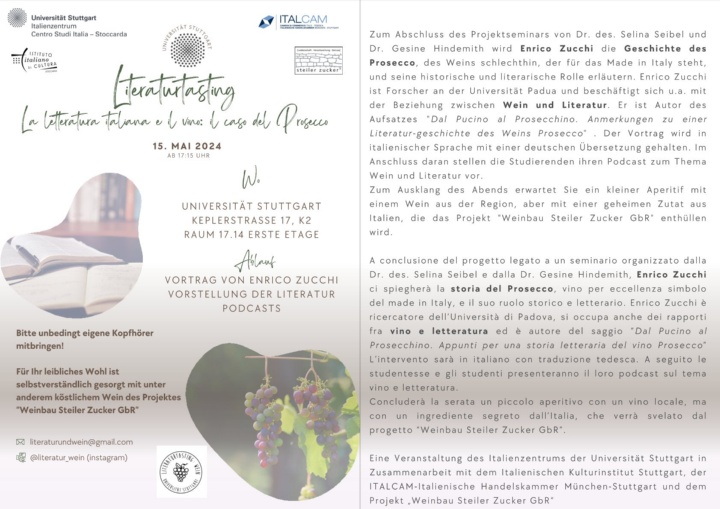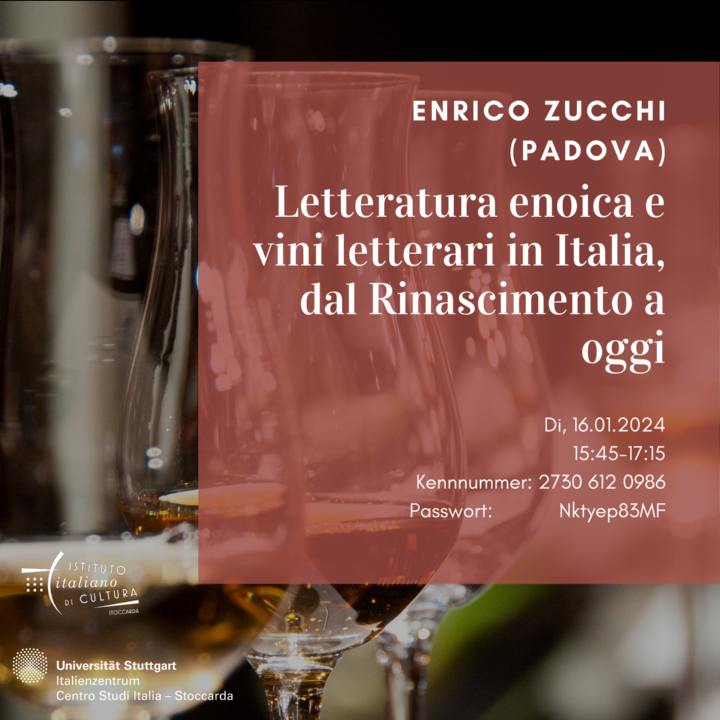Kommende Veranstaltungen
Humboldt-Stipendiatin Agnese Amaduri (Catania): Children’s literature in Fascist Italy, two case studies:
Children’s Literature in Fascist Italy, Two Case Studies: Annie Vivanti and Massimo Bontempelli
The conference is a Vischer Lecture. It is dedicated to Children’s literature in fascist Italy. In 1922 and 1923, the publishing company Bemporad, specialised in children’s literature, published two books based on Lewis Carroll’s Through the Looking Glass (and What Alice Found There) (1871). The first book is La scacchiera davanti allo specchio by Massimo Bontempelli, written in 1921; the second is Sua Altezza! (“Favola candida”) by Annie Vivanti, composed between 1921 and 1922. In the same period, two writers, very different in origin, cultural background and artistic choices, decided to take inspiration from the work of the British writer Carroll to create two novels set in an “other” world that nevertheless remains strongly linked to reality.
It does not seem inappropriate to think that the choice was influenced by the complex political and social situation that Italy was going through in those years, at a historical moment in which the stability of the institutions seemed fragile. Between 1919 and 1920, the country was going through strong social tensions, a consequence of the heavy post-war economic crisis; in this period, called the ‘Biennio Rosso’, the working class gave rise to frequent revolts, demonstrations and factory occupations. At the same time, the Fasci di combattimento were born (1919) from which the Partito nazionale fascista, led by Mussolini, was formed in 1921 and, finally, on 22th of October 1922, with the March on Rome, the so-called Ventennio fascista began in Italy.
In the midst of this period of strong political turbulence, the two writers exploit the expedient of the gateway (a mirror for Bontempelli, a painting for Vivanti) to lead their young protagonists into fantastic worlds, full, however, of pitfalls and dangers. The children are forced to interact with contradictory and despotic characters who want to limit them or keep them prisoners, and only by escaping they will save themselves. The lecture will focus on the thematic and stylistic aspects of these texts in order to highlight the common or divergent elements with respect to the model, reflecting on the possible influences that the historical-political context has played on the writing of the two works.
Prof. Antonio Sichera (Catania): Pirandello e noi
Prof. Dr.-Ing. M. Arch. Lucio Blandini (Stuttgart): La rilevanza della costruzione leggera
Filmabend an der Universität (II)
Filmabend an der Universität Stuttgart (I)
Vortrag: Damiano Garafolo (La Sapienza, Roma)
Vortrag mit Lesung von Laurian Kanzleiter (LMU München): Italien als Brücke zum ,Orient’
Lunch Lecture: Hubert Alisade (Innsbruck): Von Malabar bis Äthiopien die Beschreibung der ,drei Indien’ in Marco Polos Il Milione
Abendvortrag von Hubert Alisade (Innsbruck): Fliegende Berge, Assassinen, Salamander– Marco Polos bezaubernder Orient
Literaturtasting
Tagung: KOSTÜM(IERUNG) UND ROLLE
Informationsbroschüre des Italienzentrums
Sollte die Vorschau nicht richtig angezeigt werden, klicken Sie bitte hier.
Archiv: Informationsbroschüren der vergangenen Semester
Auftaktveranstaltung des Italienzentrums
Dialog zwischen Kunst und Literatur
Vortragsabend mit Prof. Dr. Andreas Kablitz (Köln, Romanistik) und Prof. Dr. Ulrich Pfisterer (München, Kunstgeschichte)
Anlässlich des 500. Todestags von Raffael (Sanzio da Urbino)
29. Januar 2020, 17:00-20:00 Uhr
Universität Stuttgart, KII, Raum 17.92
Veranstaltungsarchiv
Vortrag von Dott. Matteo Marchesini (Bologna)
Matteo Marchesini ci guiderà in un percorso all´interno della produzione letteraria di Pasolini con letture dai suoi esordi poetici (Meglio Gioventù, Le ceneri di Gramsci), attraverso Scritti corsari e Lettere Luterane, alcune sue recensioni e poemetti in prosa saggistica, fino all´ultima stagione, quella più libera, disillusa, che l´ha fatto affermare nel cinema come regista di successo.
Matteo Marchesini, Da Pascoli a Busi (Quodlibet 2014), Casa di carte (Il Saggiatore 2019), Scienza di niente (elliot 2020)
Moderazione: Dott.ssa Laura Mautone, Dr. Sven Thorsten Kilian
Vortrag von Dott. Manuel Koch (Rom)
(Studiengang Cinema, Televisione e Produzione Multimediale)
Vortrag von Prof. Dr. Andreas Kablitz (Köln)
Weitere Informationen erhalten Sie hier.
Dantes Divina Commedia im Rückspiegel der Kunst- und Literaturgeschichte
mit öffentlichen Vorträgen von Prof. Dr. Anette Simonis(Gießen), Prof. Dr. Andreas Kablitz (Köln), Prof. Dr. Joachim Küpper (Berlin), Prof. Dr. Cornelia Klettke (Potsdam), Dr. Dr. Antonella Ippolito (Potsdam) u. a.
Dienstags, 17:30-19 Uhr (14-tägig)
Internationale Tagung des Italienzentrums der Universität Stuttgart
Prof. Dr. Pier Mario Vescovo (Ca’ Foscari, Venedig) - Vortrag in italienischer Sprache
17.00 Uhr
(Der Vortrag wird online über Webex abgehalten)
Weitere Informationen erhalten Sie hier
Vortrag Prof. Dr. Luca Viglialoro (HBK Essen)
17.30 Uhr
(Der Vortrag wird online über Webex abgehalten)
Weitere Informationen erhalten Sie hier
Vortrag Prof. Dr. Johann Josef Böker (KIT)
9.45-11.15 Uhr (Der Vortrag wird online über Webex-Events abgehalten)
Weitere Informationen zur Anmeldung erhalten Sie hier
Vortrag von Dr. Friederike Hausmann zum 10-jährigen Bestehen der Garibaldi Gesellschaft Deutschland
Kolbstraße 6, 70178 Stuttgart , 19.00 Uhr
In Zusammenarbeit mit dem Istituto Italiano di Cultura
weitere Informationen erhalten Sie hier
27.06.-11.07.
Begegnung in Sardinien - Incontro in Sardegna
Donnerstag, 27.06:
Ausstellungseröffnung: Le foto ritrovate
Julius Konietzko (1886-1953), weltbekannter Ethnologe und Sammler exotischer Kunst, bereiste 1931 (Januar-März) mit seiner Frau Lore Sardinien mit dem Zweck, ethnografische Objekte zu kaufen und zu fotografieren. Die Fotosammlung seiner Sardinienreise besteht hauptsächlich aus Landschafts- und Architekturaufnahmen, Szenen häuslicher und bäuerlicher Arbeit und Porträts von Personen. Er besuchte zuerst Cagliari, Sant’Antioco, Oristano, Cabras, Santa Giusta und Milis. Gegen Mitte Februar fuhr er nach Nuoro und Dorgali.
In Nuoro begegnete er dem Meisterfotografen Sebastiano Guiso (1891-1955). Konietzko kaufte von ihm zahlreiche Fotos, die meist Personen in der Tracht Nuoros und aus der Umgebung abbilden und gliederte sie in seine Sammlung ein. Auch diese Fotos haben als Original-Abzüge der Zeit einen hohen dokumentarischen Wert, zumal Sebastiano Guiso vor seinem Tod sein gesamtes Fotoarchiv verbrannte. Durch den Kauf sind diese Fotos vor der Zerstörung bewahrt und nach fast einem Jahrhundert in Deutschland wiedergefunden worden. Viele der Porträtierten tragen Festtagskleidung, und man nimmt an, dass ein Großteil der Aufnahmen anlässlich des Besuchs des italienischen Königspaares Vittorio Emanuele III. und seiner Gattin Elena in Nuoro am 3. Mai 1929 entstanden ist. Aus diesem Anlass fand in Nuoro ein großer Trachtenumzug statt, zu dem aus vielen Orten der Umgebung die Trachtenträger in die Stadt strömten.
* * * * *
Julius Konietzko (1886-1953), etnologo di fama mondiale e collezionista di arte esotica, nel 1931 (gennaio-marzo) si reca in Sardegna in compagnia della moglie per acquistare oggetti di interesse etnografico. Ma approfitta del suo soggiorno anche per fotografare. I suoi soggetti preferiti sono i paesaggi, l’architettura rurale, il lavoro quotidiano, gli oggetti della cultura materiale e persone in costume tradizionale. Dopo essere stato a Cagliari, Sant’Antioco, Oristano, Cabras, Santa Giusta e Milis, verso metà febbraio parte per Nuoro e Dorgali.
A Nuoro conosce Sebastiano Guiso (1891-1955), fotografo professionista molto noto, e da lui Konietzko acquista numerose foto originali che ritraggono in prevalenza persone in costume festivo di Nuoro e di alcuni paesi del circondario. Queste foto hanno un alto valore documentale, in quanto il fotografo nuorese alcuni anni prima di morire distrusse il suo intero archivio fotografico. Pertanto le fotografie acquistate da Konietzko indirettamente sono state salvate e ritrovate in Germania dopo quasi un secolo. Alcune furono scattate probabilmente il 3 maggio del 1929, quando il re Vittorio Emanuele III e la regina Elena visitarono Nuoro. In occasione di quell’evento si riversarono nel capoluogo barbaricino grandi masse di persone vestite a festa per onorare la coppia reale con un grande corteo in costume tradizionale.
Eine Veranstaltung des Italienzentrums/IZKT der Universität Stuttgart und des Giovanni Masala Verlags (www.sardinnia.de) in Zusammenarbeit mit dem Italienischen Kulturinstitut Stuttgart.
Organisation und Einführung: Giovanni Masala
Zeit: 18 Uhr
Ort: Vortragssaal Universitätsbibliothek Stuttgart, Holzgartenstr. 16
Die Ausstellung wird vom 27.06. bis zum 11.07. im Foyer der Universitätsbibliothek zu sehen sein.
Um den Flyer einzusehen, klicken Sie hier
Dienstag, 28. Mai
Vortrag Centro Stile Fiat (Turin)
Italian Design Day - Fiat Concept Centoventi - Future Mobility with Italian Design
In diesem Jahr feiert die italienischen Marke Fiat den 120. Geburtstag. Seit jeher steht die Marke für Stil, Lebensfreude und nicht zuletzt für unverwechselbares Design. Das perfekte Beispiel dafür ist der Fiat 500, eine automobile Ikone die damals wie heute für Begeisterung sorgt. Sein klassenlos sympathischer Auftritt und seine nahezu unendliche Modellvielfalt machen den Fiat Cinquecento zu etwas Besonderem. Welchen Stellenwert das Design für die Marke Fiat hat und wie man es weiterentwickelt und immer wieder neu erfindet – das erklärt uns ein Designer aus dem „Centro Stile Fiat“ in Turin, dem Designzentrum der Marke.
Zeit: 17.30 Uhr
Ort: Haus der Wirtschaft, Mia-Seeger-Saal, Willi-Bleicher-Str. 19, 70174 Stuttgart
Um den Flyer einzusehen, klicken Sie hier
Mittwoch, 15. Mai:
Vortrag
Prof. Enrico Mattioda (Turin)
Primo Levi tra letteratura e scienza
Nel centenario della nascita di Primo Levi, Prof. Mattioda parlerà di come Levi, autore del famoso romanzo Se questo è un uomo, ha cercato vari approcci epistemologici per spiegare la storia e la Shoah.
Zeit: 19.00 Uhr
Ort: Keplerstr. 7, Senatssaal
Um die deutsche Version des Flyers einzusehen, klicken Sie hier
Um die italienische Version des Flyers einzusehen, klicken Sie hier
Kontakt

Kirsten Dickhaut
Prof. Dr.Geschäftsführende Direktorin des Instituts für Literaturwissenschaft (ILW) | Abteilungsleiterin Romanische Literaturen I (Galloromanistik) und II (Italianistik)

Selina Seibel
Koordinatorin des Italienzentrums














